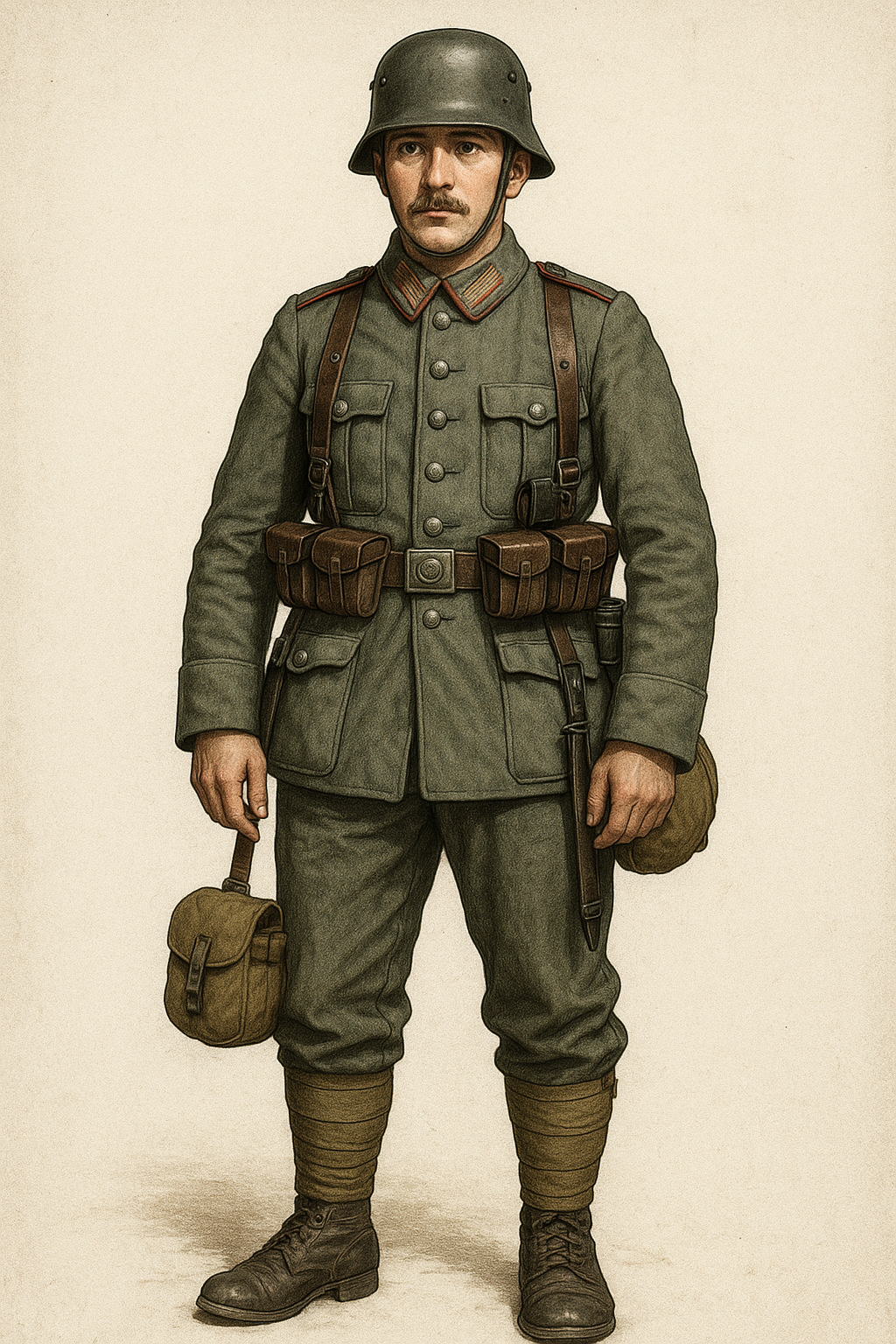
WW1 German Army Uniform Explained: Tunics, Helmets, and Field Gear"
Published on Jun 29, 2025
WW1 German Uniform: A Legacy of Function and Form
World War I marked a significant shift in military tactics, technology, and apparel. Among the most iconic images from this era is the German soldier clad in field-gray (feldgrau), equipped with gear designed for the brutal conditions of trench warfare. The German WW1 uniform wasn’t just a costume—it was a carefully constructed tool of war.
1. The Origins of the WW1 German Uniform
Prior to WW1, the German military favored colorful and ornate uniforms reminiscent of 19th-century warfare. However, as modern warfare loomed, visibility on the battlefield became a liability. By the early 20th century, the Prussian-led German Empire introduced feldgrau, a muted gray-green uniform that symbolized both practicality and unity across the imperial German states.
2. Key Components of the German WW1 Soldier's Uniform
a. Feldbluse (Field Tunic)
The standard tunic worn by infantrymen was the M1907/10 Feldbluse, later replaced by simplified versions like the M1915. These tunics featured:
- Wool fabric for warmth
- Stand-and-fall collars
- Colored piping indicating unit types
- Six-button front (reduced in later models)
- Shoulder straps for rank and regiment
b. Trousers (Hosen)
Soldiers wore durable wool trousers, usually in matching feldgrau. These were high-waisted and often tucked into boots or wrapped with gaiters for added protection.
c. Pickelhaube (Spiked Helmet)
Perhaps the most visually distinct element, the Pickelhaube was made of leather with a brass spike on top. While iconic, it proved ineffective against shrapnel. By 1916, the German army replaced it with the sturdier Stahlhelm (steel helmet), designed to protect from overhead shell fragments.
d. Stahlhelm
Introduced in 1916, the M1916 Stahlhelm became the standard and remains a symbol of the German soldier. Its sloped design inspired helmets used by armies around the world.
e. Footwear
Early war boots, known as Marschstiefel or jackboots, were knee-high and made of leather. As material shortages hit, ankle boots with gaiters became more common.
f. Equipment and Gear
- Belt and Buckle: Often inscribed with “Gott mit uns” (“God with us”)
- Breadbag and Mess Kit: Essential for carrying food
- Gas Mask Canister: Introduced after 1915 in response to chemical warfare
- Ammunition Pouches & Bayonet: Worn on the belt for immediate access
3. Uniform Colors and Materials
The feldgrau color evolved throughout the war due to dye shortages, resulting in various shades from gray-green to brownish hues. Wool was the primary material, chosen for its availability and insulating properties.
As the war dragged on, resource scarcity forced the German army to use lower-quality materials, often resulting in a more rugged appearance.
4. Rank and Insignia
German uniforms included:
- Shoulder straps with colored piping to indicate regiment
- Collar patches for branch identification
- Cuff titles and chevrons to show rank or honors
- Medals and awards, such as the Iron Cross, often pinned on the chest
5. Evolution Throughout the War
From 1914 to 1918, the German uniform underwent several changes:
- Decorative features were simplified or eliminated
- Materials became coarser
- Field gear became more standardized
- Camouflage techniques were introduced in later war years
6. Influence on Military Fashion
The design of the German WW1 uniform, particularly the Stahlhelm and minimalist color scheme, influenced military uniforms globally. The concept of blending into the environment became a core principle in military outfitting.
7. Collecting and Reenactment Value
Today, German WW1 uniforms are highly prized among collectors, historians, and reenactors. Authentic pieces, such as original Pickelhauben, tunics, or boots, can fetch high prices on the militaria market. For reenactments or historical displays, accurate reproductions are commonly used to preserve originals.
8. Reproductions and Where to Buy
For enthusiasts or museums seeking authentic German soldier WW1 uniforms, websites like Paddelaters.com offer high-quality reproductions made with attention to historical detail. Whether for display, reenactment, or education, these uniforms help keep history alive.
Why the German WW1 Uniform Still Matters
The German soldier WW1 uniform is more than just fabric and gear—it’s a symbol of a world undergoing dramatic change. From aristocratic armies to industrialized warfare, this uniform tells a story of evolution, adaptation, and resilience.
For collectors, military historians, educators, or curious minds, exploring the intricacies of the German WW1 uniform opens a unique window into one of the most transformative periods of human history.
Conclusion
The German soldier WW1 uniform is not only a reflection of military utility but also a powerful symbol of a rapidly modernizing era. From the iconic pickelhaube to the pragmatic feldgrau tunics and steel helmets, each element tells a story of innovation, adaptation, and survival in one of history’s most devastating conflicts.
As we study and preserve these uniforms—through collecting, reenactments, or museum exhibitions—we also preserve the memory of the soldiers who wore them. Their clothing offers insights into the conditions they faced, the values they fought for, and the historical legacy they left behind.
For enthusiasts, historians, and collectors alike, understanding the intricacies of the German WW1 uniform opens the door to deeper appreciation and continued exploration of World War I history.
